|
|
|
Sort Order |
|
|
|
Items / Page
|
|
|
|
|
|
|
| Srl | Item |
| 1 |
ID:
128146
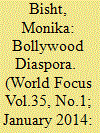

|
|
|
|
|
| Publication |
2014.
|
| Summary/Abstract |
The liberalization and the forces of globalization enhance the employment options, expansion of service sector and demand of skills across the borders. With this liberalization of the economy, a growing number of NRIs primarily from the United States and United Kingdom have also begun investing in their cultural homeland (Pulkit Datta: 2008). The aspiration of better lives and employment opportunities expanded the size of middle class abroad during 1990s, the terms "Non Resident Indian" emerged for the Indian who is living abroad. This is why; this period can be considered as the Golden Age of the NRI, which resulted the emerging middle class and the new material aspirations of an India in the midst of economic liberalization (Ingrid Thewath:2010).
|
|
|
|
|
|
|
|
|
|
|
|
|
|
|
|
| 2 |
ID:
128206
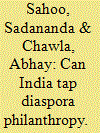

|
|
|
|
|
| Publication |
2014.
|
| Summary/Abstract |
International migration and diaspora has been one of the integral parts of the recent development discourse in academics as well as the policy domain, especially in the context of developing countries. Diaspora is seen as one of the emerging development actors as diaspora is perceived as creating economic, social and political capital through global network (Gaillard 1991, Meyer Brown 1999). Multilateral organizations have taken note of the significance of diasporic contribution towards the global development.
|
|
|
|
|
|
|
|
|
|
|
|
|
|
|
|
| 3 |
ID:
128140
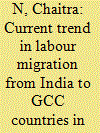

|
|
|
|
|
| Publication |
2014.
|
| Summary/Abstract |
Migration and movement of human population have always been an integral element in the history of mankind. India has been experiencing large-scale migration to foreign countries since centuries and in the current globalised era. The International Labour Organization - ILO has classified international migration for employment in to two major categories including settlement migration and contract migration (ILO, 1989). The contract migration is unique phenomenon practiced in few western countries but in particular in the GCC countries post oil boon during 1970's as the governments used sharply higher oil revenue to build infrastructure and housing, and expand the economy (Seccombe, 1985).
|
|
|
|
|
|
|
|
|
|
|
|
|
|
|
|
| 4 |
ID:
128182
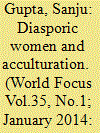

|
|
|
|
|
| Publication |
2014.
|
| Summary/Abstract |
Diasporas are the human face of the globalization process. The contemporary importance of Diasporas can be related to the seemingly contradictory historical processes of consolidation of national cultural identities and large international migrations. Though the phenomenon of migration is as old as the existence of humanity, international migration on a large scale started during colonial times. Labour demand, political conflicts, technological changes and trade and commerce together, contribute to international migration becoming one the most important determinant of modern global change.
This paper attempts to explain the cross cultural conflicts, trauma, isolation, aspirations and dilemmas of the Indian Women immigrants in Jhumpa Lahiri's The Namesake , especially Aashima Ganguly, who find herself in between the native culture and host culture and her trishanku experience of being neither in Calcutta nor in America which is at the very centre of diasporic trauma. Ashima is a true representative of the majority of women expatriates who are reluctant to change or adapt to the culture of the host country. But still she sacrifices all her comforts for the sake of her family and like the typical traditional Indian women; her life revolves around her husband and children.
|
|
|
|
|
|
|
|
|
|
|
|
|
|
|
|
| 5 |
ID:
128199
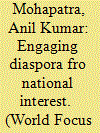

|
|
|
|
|
| Publication |
2014.
|
| Summary/Abstract |
The growing influence of diasporas on foreign affairs and the international behavior of the states has been a worldwide academic finding and a reported fact. As independent actors they have operated as lobbies which have actively influenced homeland (ancestral or kin-states) foreign policies and that of the host lands as well (Shain et al 2003). Especially the developing countries in their mission of development have tried to rope in their communities abroad in the process. This global phenomenon of diaspora-homeland linkage has debate on economic and political systems, national culture and international relations.
|
|
|
|
|
|
|
|
|
|
|
|
|
|
|
|
| 6 |
ID:
128139
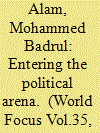

|
|
|
|
|
| Publication |
2014.
|
| Summary/Abstract |
The Indian community in United States is one among many ethnic communities, which have been increasingly visible in the last four decades. Although the flow of Indians as new ethnic started first as a trickle in 1895, their impact was really felt in the aftermath of the landmark 1965 immigration legislation. This new immigration groups has begun to attract academic attention and has to been the focus of research by a number of scholars.
|
|
|
|
|
|
|
|
|
|
|
|
|
|
|
|
| 7 |
ID:
128141
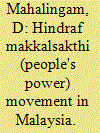

|
|
|
|
|
| Publication |
2014.
|
| Summary/Abstract |
HINDRAF, the Hindu rights advocacy group spearheaded and organized the Indian spring on November 24, 2007 on the eve of golden jubilee year of Malaysia's independence and confronted the Malaysian state in a bid to highlight the predicament of the Indian ethnic minority. The political mobilization was popularly known as HINDRAF Makalsakthi movement as a huge numbers of Indian belonging to different strata overwhelmingly participated - even thought there was threat and intimidation from the ruling establishments against participation to vent out their anger.
|
|
|
|
|
|
|
|
|
|
|
|
|
|
|
|
| 8 |
ID:
128142
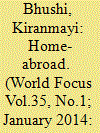

|
|
|
|
|
| Publication |
2014.
|
| Summary/Abstract |
There are various play of forces, institutions and actors that make up the transnational space, which effectively bring home and abroad together in newer ways than before. This paper purports to highlight these aspects of the transnational space. Transnational space and the related terms transnationlism is said to capture a condition in which despite great distances and notwithstanding the pretense to international borders, certain kinds of relationship are globally intensifying and have become denser between places and people.
|
|
|
|
|
|
|
|
|
|
|
|
|
|
|
|
| 9 |
ID:
128144


|
|
|
|
|
| Publication |
2014.
|
| Summary/Abstract |
This paper attempt to offer insights into the complexity of what can be broadly termed as the South African Indian (SAI) identity through a study of their unique historical trajectory and experiences in the context of the apartheid era, that began in 1948, and the post apartheid phase. Since the dismantlement of the racist regime and first democratic elections in 1994, the SAI community is at across road.
|
|
|
|
|
|
|
|
|
|
|
|
|
|
|
|
| 10 |
ID:
128205
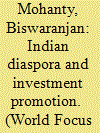

|
|
|
|
|
| Publication |
2014.
|
| Summary/Abstract |
The Indian government's recent high level committee report on the e Indian Diaspora estimates that almost 20 million people of Indian origin live overseas. India has the second largest diaspora in the world. The overseas Indian community estimated at over 25 million is spread across every major region in the world. Some section of the Indian diaspora have acquired global identity and are promoters of the emerging concept of global citizenship.
|
|
|
|
|
|
|
|
|
|
|
|
|
|
|
|
| 11 |
ID:
128183
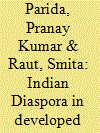

|
|
|
|
|
| Publication |
2014.
|
| Summary/Abstract |
The Indian Diaspora is a genetic term to describe the people who migrated from territories that are currently within the border of the Republic of India. It also refers to their descendants. The Diaspora is currently estimated to number over twenty million composed of NRI-Indian citizens not residing in India and PIO-persons of Indian Origin who have acquired the citizenship of some of other country. The Diaspora covers practically every part of the world.
|
|
|
|
|
|
|
|
|
|
|
|
|
|
|
|
| 12 |
ID:
128185


|
|
|
|
|
| Publication |
2014.
|
| Summary/Abstract |
Etymologically 'diaspora' means any people or ethnic population forced or induced to leave their traditional homelands; being dispersed throughout other parts of the world, and the ensuing developments in their dispersal and culture. Historically, the terms 'diaspora' was initially uses by the ancient Greeks to refer to citizen of grand city who migrated to a conquered land with the purpose of colonization to assimilate the territory into the empire. The original meaning was cut off from the present meaning when the old testament was translated to Greek: the word diaspora was used to refer specifically to the populations of Jews exiled from Judea in 586 B C by the Babylonians, and Jerusalem in 136 AD by the Roman empire.
|
|
|
|
|
|
|
|
|
|
|
|
|
|
|
|
| 13 |
ID:
128143


|
|
|
|
|
| Publication |
2014.
|
| Summary/Abstract |
Dynamics of Indian Diaspora in East Africa has been continuous point of attraction for researchers, academicians, policy makers and even general audience. Even a cursory glance reveals that dozens of research has been carried out by scholars and numerous literatures are available on the subject. However, there have been significant changes in the focus of the research. In the colonial period, political activism of Indians in East Africa was a major point contention between colonial power and nationalist leaders which is clearly visible in the writings of CF Andrews (Indian question in East Africa, 1921).
|
|
|
|
|
|
|
|
|
|
|
|
|
|
|
|
| 14 |
ID:
128176
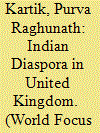

|
|
|
|
|
| Publication |
2014.
|
| Summary/Abstract |
After 1950s a large number of Indians migrated to United Kingdom (UK) with cultural, traditions and religious values and practices, which included practice of caste discrimination too. As Dr. BR Ambedkar anticipated, the Indian migrants will carry the caste system to other regions of earth and it would become a problem of the world. This prediction came true as cast discrimination has indeed migrated with the Indian Diaspora to east and south Africa, Mauritius, Fiji, Surinam, the middle east (for example in Bahrain, Kuwait, the United Arab Emirates), Malaysia, the Caribbean, the United Kingdom, North America, and other regions (Natural 2001). With the other Indian Diaspora dalits (untouchables) of India also migrated to the UK. It has been estimated that around 250000 dalits are living in the UK (CERD 79, UK Report.).
|
|
|
|
|
|
|
|
|
|
|
|
|
|
|
|
| 15 |
ID:
128190
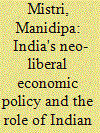

|
|
|
|
|
| Publication |
2014.
|
| Summary/Abstract |
Like other developing countries, India also faced a huge economic crisis during 90s. Basically, over the 80s there was a large and growing fiscal imbalance going on in the Indian economy and from mid 80s, India started facing problems related to balance of payments. Because of the Gulf war, India's export business decreased, oil import bill increased, credit dried up and investors were apprehensive about more investment. All these factors together led to a serious economic crisis during the end of 1990 and the government was close to default, foreign exchange reserves had been reduced and as a result, India had to airlift its gold reserves as a pledge in order to secure desperately needed international financing from international monetary fund (IMF). And, in this context, in order to secure its economy from financial crisis and to attract huge foreign direct investment (FDI), India had taken significant policy shifts in the beginning of the 90s. This new model of economic reforms is known as the neo liberal economic policy of India or LPG (liberalization, privatization and Globalization) model. The main objective of this model was to make the Indian economy as the fastest developing economy in the world which will be able to match up with the biggest economics of the world. Soon after, the government started introducing some new polices which include foreign technology agreements, foreign investment, deregulation, privatization, industrial licensing and abolition of license raj and, following the new liberal polices of India from Indian origin from different parts of the globe and overseas Indians stretched their hands with full of help to overcome this financial crisis in a number of ways. Starting from help in privatization, industrialization and foreign direct investment they have always supported their traditional homeland.
|
|
|
|
|
|
|
|
|
|
|
|
|
|
|
|
| 16 |
ID:
128137
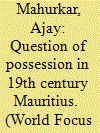

|
|
|
|
|
| Publication |
2014.
|
| Summary/Abstract |
This paper is based on the debates on the questions of possessions I recovered from the Mauritius section of the university of Mauritius library. The Mauritius Supreme Court from mid 19th century onward was quite concerned about this question at a time when the planters were selling off portions of land to Indians and others in a phenomenon referred to as grand morcellement
|
|
|
|
|
|
|
|
|
|
|
|
|
|
|
|
| 17 |
ID:
128184
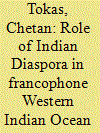

|
|
|
|
|
| Publication |
2014.
|
| Summary/Abstract |
Western Indian ocean islands of Seychelles, Mauritius, Madagascar, Reunion and Comoros have played significant role in migration of people and flow of goods across Indian Ocean for centuries. European powers in order to control sea lanes had firmly worked on acquiring military significance over the Western Indian Ocean region during colonial era. Revolution, Comoros, Madagascar, Seychelles and Mauritius have remain French colonies or were occupied by France for certain period of time.
|
|
|
|
|
|
|
|
|
|
|
|
|
|
|
|
| 18 |
ID:
128147
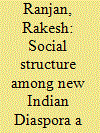

|
|
|
|
|
| Publication |
2014.
|
| Summary/Abstract |
A diaspora exists precisely because it remembers the 'homeland' without this memory this migrants and settlers would be simply people in a new setting, into which they merge, bringing little or nothing to the new home, accepting in various way and forms the mores and attitudes that already exists in their new country and society … The people of the Diaspora, however do not merely settle in new countries: they recreate in their socio-economic, political and cultural institutions a version of that homeland that they remember. (Reeves and Rai 2006: 17).
|
|
|
|
|
|
|
|
|
|
|
|
|
|
|
|
| 19 |
ID:
128145
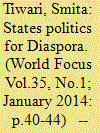

|
|
|
|
|
| Publication |
2014.
|
| Summary/Abstract |
Migration is a natural continuous and spatial phenomenon. People move from one place to another and create Diaspora in the form of transnational network. As Sheffer says, modern Diasporas are "ethnic minority groups of migrant origins residing and acting in host countries but maintaining strong sentimental and materials links with their countries of origin their homelands". (Sheffer, 1986:3). Modern Diasporic communities which live outside but maintain link with their country of origin are getting larger and stronger, and influencing both domestic politics and foreign relations of a states.
|
|
|
|
|
|
|
|
|
|
|
|
|
|
|
|
|
|
|
|
|